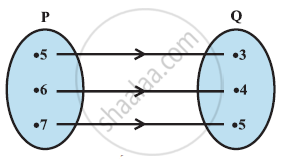Advertisements
Advertisements
प्रश्न
Multiple Choice Question :
Let n(A) = m and n(B) = n then the total number of non-empty relation that can be defined from A to B is ________.
विकल्प
mn
nm
2mn – 1
2mn
उत्तर
Let n(A) = m and n(B) = n then the total number of non-empty relation that can be defined from A to B is 2mn – 1.
APPEARS IN
संबंधित प्रश्न
The given figure shows a relationship between the sets P and Q. Write this relation
- in set-builder form.
- in roster form.
What is its domain and range?

Determine the domain and range of the relation R defined by
(i) R = [(x, x + 5): x ∈ (0, 1, 2, 3, 4, 5)]
Let A and B be two sets such that n(A) = 3 and n(B) = 2. If (x, 1), (y, 2), (z, 1) are in A × B, write A and B
If `(x + 1/3, y/3 - 1) = (1/2, 3/2)`, find x and y
Write the relation in the Roster Form. State its domain and range
R5 = {(x, y)/x + y = 3, x, y∈ {0, 1, 2, 3}
Represent the given relation by
(a) an arrow diagram
(b) a graph and
(c) a set in roster form, wherever possible
{(x, y) | x = 2y, x ∈ {2, 3, 4, 5}, y ∈ {1, 2, 3, 4}
Discuss the following relation for reflexivity, symmetricity and transitivity:
On the set of natural numbers the relation R defined by “xRy if x + 2y = 1”
On the set of natural numbers let R be the relation defined by aRb if a + b ≤ 6. Write down the relation by listing all the pairs. Check whether it is transitive
Choose the correct alternative:
The rule f(x) = x2 is a bijection if the domain and the co-domain are given by
If R1 = {(x, y) | y = 2x + 7, where x ∈ R and – 5 ≤ x ≤ 5} is a relation. Then find the domain and Range of R1.
